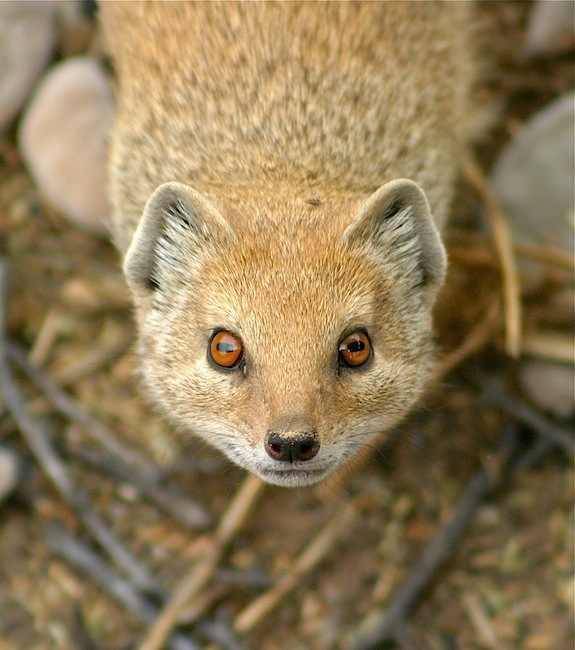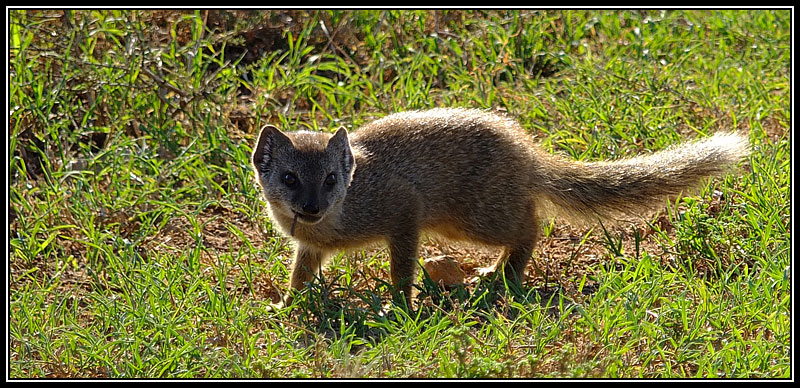Page 1 of 7
Re: Mongoose
Posted: Wed May 23, 2012 9:21 pm
by Lisbeth
Rietvlei Reserve

Re: Mongoose
Posted: Mon Jul 08, 2013 7:38 pm
by ExFmem
Yellow Mongoose: Behavior
The yellow mongoose is primarily diurnal, spending most of its day foraging, although it is sometimes active at night. They occupy permanent burrows which they often cohabit with ground squirrels and suricates. The yellow mongoose is a social species. Colonies are usually centered around a family group consisting of a male and a female, their youngest offspring, and other individuals consisting of subadults, very old adults, or individuals with some sort of association to the group.
Yellow mongooses are regarded as the most important rabies vectors on the central plateau of South Africa.

(KTP)
Yellow Mongooses have a characteristic white tail tip.

Mongooses have horizontal pupils. Why is this advantageous for them?
In prey animals the eyes are placed towards the sides of the head. The advantage of having horizontal pupils is that it helps to create a panoramic vista giving the prey animal a much wider peripheral view around its body. This allows it to easily scan its environment for danger.
Examples of a few animals with vertical slits include crocodilians, vipers, cats, and foxes. A smaller array of animals exhibit the horizontal slit, including sheep, goats, kangaroos, hippopotami and mongooses.
Re: Mongoose
Posted: Mon Jul 08, 2013 7:44 pm
by Flutterby
Great info and pics ExFmem!!


Re: Mongoose
Posted: Wed Jul 10, 2013 6:52 pm
by nan
Yellow Mongoose
21.3.2013 my friend


Re: Mongoose
Posted: Wed Jul 10, 2013 7:38 pm
by Richprins
Re: Mongoose
Posted: Thu Jul 11, 2013 6:37 pm
by ExFmem
Re: Mongoose - Animal of the Month: March 2014
Posted: Fri Mar 07, 2014 8:02 am
by PJL
Re: Mongoose - Animal of the Month: March 2014
Posted: Fri Mar 07, 2014 10:57 am
by Lisbeth
Re: Mongoose - Animal of the Month: March 2014
Posted: Fri Mar 07, 2014 9:20 pm
by Super Mongoose
Yellow Mongoose – Cynictus Penicilata (Witkwasmuishond)

Picture:
http://commons.wikimedia.org/wiki/File: ... ngoose.JPG
Info: The Mammal Guide of Southern Africa, Burger Chillè, Briza publishers.
Description:
Over most of its range the color varies from yellowish-red in the South-East through shades of yellow to greyish-yellow in the North-West, with a white tip on the trail. In the Northern parts of Botswana the animals are grey with speckles without the white tip of the tail. They are also much smaller with shorter hair and tails. The legs, chin, chest and throat of the Yellow Mongoose are slightly lighter in color than the rest of the body. The Slender Mongoose is sometimes yellowish, but always has a black-tipped tail.
Sexual dimorphism:
None
Food:
Beetles, termites, crickets, locusts, mice, ground birds and small reptiles.
Habitat:
Open grassy plains. They usually avoid bushy areas.
Habits:
They are gregarious animals and are found in colonies up to 20 and more. The colonies in Botswana are usually smaller. Yellow Mongooses often live socially with Ground Squirrels and Meerkats, but may also dig their own burrows. These consist of many tunnels, corridors and entrances. The animals are mainly diurnal but sometimes active after dusk. The forage far away from their dwelling holes and when danger threatens they make use of any shelter available.
Voice:
Unknown
Breeding:
2 to 5 young are born from October to March after a gestation period of plus/minus 8 weeks.
Enemies:
Leopard, lion, brown hyena, black-backed jackal and African Wild Cat.
Distribution Africa:
 Info: The Mammal Guide of Southern Africa, Burger Chillè, Briza publishers.
Info: The Mammal Guide of Southern Africa, Burger Chillè, Briza publishers.
Re: Mongoose - Animal of the Month: March 2014
Posted: Sat Mar 08, 2014 11:51 am
by Lisbeth
Yellow mongoose - Rietvlei Nature Reserve




 (KTP)
(KTP)





